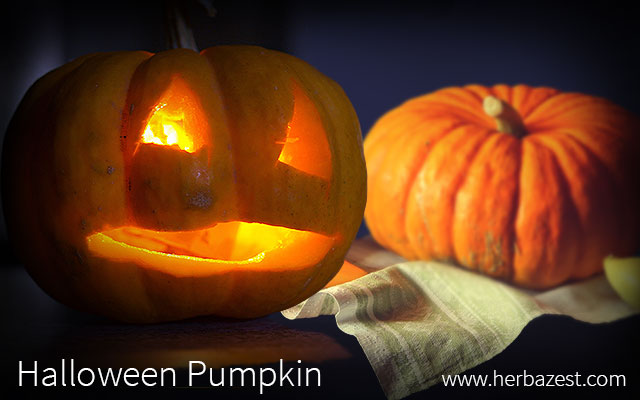Pumpkins and Halloween have been inextricably linked ever since early European settlers began using them to light the night on All Saints' Day. Widely available throughout the autumn season, these brightly-colored majestic fruits are quite versatile and give way to a number of fun, family-friendly uses.
Origin of the Halloween Pumpkin
The present day jack-o'-lantern has its origins in a popular Celtic legend that recounts the story of Jack, a conniving man who manipulated the devil into performing personal favors for him without obtaining his soul. Denied entry into both heaven and hell at the time of his death, the fate of Jack's spirit was to wander the dark Earth with only the light of a small turnip lantern to guide him. He became known as Jack of the Lantern.
Likewise, the Irish and Scottish made their own little lanterns, carving spooky faces in them to ward off creepy Jack and other tortured souls. Upon their arrival in the Americas, they would use the pumpkin for Halloween carving. This New World fruit, larger than the European turnips and gourds, produced better jack-o'-lanterns.
Best Pumpkin for Halloween
A medium-sized orange pumpkin is still considered the standard Halloween pumpkin, ideal for carving jack-o'-lanterns. Medium-sized pumpkins of the jack-o'-lantern variety include 'Spirit', 'Autumn Gold', and 'Magic Lantern'; they weigh approximately 10 - 20 pounds (5 - 9 kg). Meanwhile, some examples of larger varieties of 20 - 40 pounds (9 - 18 kg) are 'Gold Rush', 'Connecticut Field', 'Gladiator', and 'Gold Medal'.
Some miniature pumpkins and alternatively-colored pumpkins, like 'Baby Boos' and 'Sweetie Pies', have gained traction in recent years because of the unique possibilities they offer for carving, crafting, and decorating.
Is Halloween Pumpkin Edible?
The modern cultivars of the jack-o'-lantern variety are edible and conform to market standards of appearance. The 'Autumn Gold', for example, is among the top-rated pumpkin hybrids. Its hull can be roasted and used in hearty entrees, while its seeds serve as a healthy, satiating snack.
Additionally, the flesh of Halloween pumpkins is often used as the base of a number of breads, stews, beverages, and other recipes.
Where to Buy Pumpkins for Halloween
In the fall, pumpkin patches, farmers' markets, supermarkets, and pumpkin festivals are all excellent places to find a good Halloween pumpkin. Choosing one will largely depend on its function and use, although generally those with unbruised skin and sturdy stems are preferable.
Prices will vary depending on size and overall attractiveness - miniature pumpkins and smaller gourds are likely to sell for a dollar or two, while about five dollars can be expected for standard jack-o'-lanterns.
How to Preserve Your Halloween Pumpkin
The easiest way to prolong the life of a carved Halloween pumpkin is by submerging it in a bleach solution for at least eight hours and then applying a commercial spray.
On the other hand, the pumpkin flesh you scooped out can be cooked and preserved in glass jars in the fridge to make it available for a variety of culinary uses throughout the year.
Finally, uncarved pumpkins can last for several months in a dry, airy location, at 50 - 55F (10 - 13C) with a relative humidity of 60 - 75%. Depending on their size, pumpkins also can be stored in the freezer.
What to do with Pumpkins After Halloween
There's no need to toss your Halloween pumpkin into the wastebasket - there are a number of alternatives after the fall festivities are over:
- Compost. Used pumpkins that have not been treated with toxic chemicals can be thrown in the compost bin and later used as a nutrient-rich fertilizer.
- Decorating. Some unopened pumpkins that are still in good condition may be put to excellent use as centerpieces or windowsill and mantelpiece decorations.
- Cosmetics. The flesh of pumpkins is loaded with powerful antioxidants and minerals that support healthy skin. A pumpkin facial mask can be made with honey, coconut oil, banana, or vitamin E oil.
- Livestock feed. A number of farms will accept leftover pumpkin donations - as long they are not treated with chemicals - as feed for cattle, horses, and pigs.
Choosing a pumpkin for Halloween can be a tricky business. They have changed a great deal over the years, but one thing that remains certain is that without the pumpkin, Halloween as we now know it would surely lose its special charm.
Sources
- Pumpkin: The Curious History of an American Icon, pp. 112-164
- The Colonial Williamsburg Foundation, Some Pumpkins!, Halloween and Pumpkins in Colonial America, 2009
- University of Arkansas, Division of Agriculture, Home Gardening Series, Pumpkins
- University of Illinois, Extension, Pumpkins and More
- University of Missouri, Extension, Missouri family, From Harvest to Health, Pumpkins




